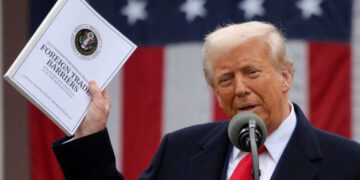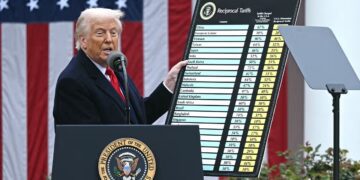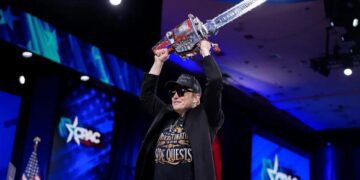By John F. Di Leo -
As the Trump administration has focused heavily on trade this year, it has been instructive to note the weight that has been placed on intellectual property, in both the negotiations and the results.
The new USMCA treaty – the intended replacement for NAFTA – includes a whole chapter on intellectual property (IP). 2018’s wave after wave of punitive tariffs on Chinese goods, too, have been imposed in an effort to stem not only the loss of American jobs to China, but the loss of American how-to as well.
Even the new layers of 10% and 25% additional tariffs on raw materials of steel and aluminum, generally dismissed as job protection efforts, are actually designed, at least in part, to help keep the technology associated with such materials here in the United States.
In the USMCA, the new intellectual property chapter focuses carefully on all aspects of IP: copyright on music, books, and film… Patents on products and technology… trademarks for companies and their brands. Unlike the “Rules of Origin” portion of the agreement, which only applies to the goods for which users seek duty free benefits, the IP section applies to everything, and is a condition of each country’s participation. If Mexico and Canada wanted a trade deal, they had to agree to step up their respect for our IP rights across the board, and to promise to enforce them.
This is a good thing; and no one should diminish its value, as far as it goes. If the USMCA is ratified by all three countries, and goes into effect in 2019 as expected, that will be good for IP rights in North America, particularly since it’s part of the template for the several other free trade agreements that this administration hopes to establish in the coming years.
Existing protections
Now, this isn’t completely new to US trade policy. It’s not like the government just discovered IP yesterday. We have long had some tools in place in these areas, because these risks have plagued us for a long, long time.
There are people who send designs to clothing customizers, unaware that those designs aren't yet in the public domain. There are people who hire overseas fabricators, giving them their own designs to assemble, unaware that those fabricators will make twice as many, one batch to fulfill the contract and a second batch to secretly sell on the side. There are overseas plants that have engineers working around the clock to reverse-engineer every product they can make a buck on, either by selling their own versions under their own name or by shamelessly stealing the logo and passing them off as legitimate. If there is IP in the world, there are people who will figure out a way to steal it; the challenge is to make it harder to do, and to increase the penalties when it's caught.
One example of the many IP tools the US government has long provided is the US Customs service’s ongoing invitation to the holders of copyrights and trademarks to register them with Customs, so that Customs can build a license review into the Customs clearance process on importations.
Let’s say, for example, that the Walt Disney Company registered their trademarks with Customs. A store imports hundreds of T-shirts, sweatshirts, and toys bearing Disney logos or likenesses. Customs will now require that importer to provide copies of his license with Walt Disney, demonstrating his right to import the product… or demonstrating Disney’s permission authorizing the foreign manufacturer to produce them in the first place.
The utility of any such tool is limited. In this case, the tool is dependent upon Customs discovering the presence of a registered logo or likeness in the first place. Since Customs only physically inspects a fraction of imported goods, and only a percentage of the documents they see would mention such a trademark, this license checkpoint is good, but not perfect. Many unauthorized knock-offs continue to get through every day (though Customs does catch a surprising amount).
Another of Customs’ ongoing efforts to protect American IP is on the financial side, in one of the more challenging aspects of Customs valuation regulations, one known as the Dutiable Assist.
To put it briefly, Customs duties are assessed on the true Customs value of the imported good, which may not be the price on an importer's invoice. This Customs value – the “entered value for Customs purposes” – includes not only the invoice price of the product, but also any additional cost or value that the importer has directly (or indirectly) provided to his foreign vendor at no charge (or reduced charge), which contributed to the production or value of the imported good.
In other words, if we import a part that required injection molding, and we sent the mold to the foreign vendor, then the delivered value of that mold must be added to the invoice price of the goods, when we calculate our import duties. Or if we hired a foreign engineering firm, directing that firm to provide technology to the foreign vendor, then that provision too is a durable assist, and must be added to the invoice value of the goods so that appropriately higher duties are assessed.
Making this foreign engineering service dutiable is just another small way that US law attempts to discourage the outsourcing of manufacturing that involves technology.
But there is an exception: if that engineering work was performed in the United States, then it is exempt from the assist process. Try not to export your technology, and the government rewards you, to the extent it can.
The government has another important IP protection process, outside of the Customs arena: the U.S. Export Controls bring civil and even criminal prosecution to the table.
Many products – obviously not all, but many sensitive products – such as those customized for defense, or suitable for nuclear and satellite technology, and the host of products, technologies, and software that are known as "dual use," are heavily restricted in the United States export control regime. For many of these goods, technology, and software, a company must seek and obtain export licenses from the federal government – usually from the State or Commerce departments – before it can share materials, components, dies and molds, technical specs, data, or any of the many other assorted aspects of the intellectual property concerned, with entities in or representing certain foreign countries.
While such product controls don't apply equally to all products, they apply to more than most people and most companies realize. It’s all part of our government’s effort to keep important knowledge at home, not only for the good of the manufacturing community, but for national security and foreign policy reasons.
These and many other existing programs have long been in place, and they do help. But they are not nearly enough.
The addition of greater IP requirements to our trading partners’ lawbooks is a good thing. It is a step forward, one to be welcomed and appreciated.
But in the end, as with any crime, the punishment primarily kicks in after the crime has occurred, and the perpetrator has been caught. That is really not enough… especially when we consider how long the exportation of American IP has been going on, both intentionally and unintentionally.
With modern tools, modern transportation, and sadly, the modern immorality that grips a fallen world, IP piracy is rampant in nearly every field of endeavor. From bootleg movies and music to knock-offs of clothing, purses, toys and games… from reverse engineering of complex manufacturing processes to the marketing of high-tech goods under someone else’s logo, or even through unauthorized use of your own… As much as they try, it is impossible for our government to ever stay ahead of such attacks on our manufacturing sector.
Every time an American company opens a factory in China, Malaysia, India, or Taiwan… Every time we hire a toll manufacturer in Mexico, Brazil, Taiwan or Vietnam… We are sending our molds and dies, our bills of material, our technical specs, our know-how… to a foreign country where it is easier for a thief to steal it that it is back home.
Not to say that intellectual property theft doesn’t occur right here in the United States. Of course it does. But the temptations are less, and the enforcement is greater, here at home. Overseas, where sharing the trade secrets of one’s former employer might result in doubling or tripling a salary, it happens all the time, and is much harder for us, an ocean away, to catch, to prosecute, or to stop.
As helpful as our many existing efforts (such as the ones mentioned above) may be, and as welcome as the new IP standards in the USMCA are as well, the fact remains that American businesses are asking for trouble every single time they outsource their products to a foreign vendor, every time they establish their own plant overseas, every time they send technology abroad – mistakenly trusting a handshake, a process, even a contract with a foreign business or its employees.
Developing nations sometimes find it irresistible to put their lower labor costs to use in producing anything that will sell, whether they have the moral right to the technology or material or not.
It’s just the way things are, and we are fools to imagine we live in a dreamworld where IP theft won’t happen because of a clause in a treaty, or a promise made by some well-intentioned trade ambassador, plant manager, or $3/day employee, halfway around the world.
In the final analysis, the only way to truly protect our intellectual property is to keep it at home whenever possible.
However many carrots and sticks the Trump administration may add to trade policy and trade law, it all comes down to keeping our manufacturing at home, by making these United States a more desirable and economical manufacturing location, so that the temptation to export our precious technology to tempt copycats abroad is reduced.
And finally…at long last, after decades of neglect… that’s on the agenda too.
Copyright 2018 John F. Di Leo
John F. Di Leo is a Chicagoland-based Customs broker and trade compliance trainer. His columns appear regularly in Illinois Review.







